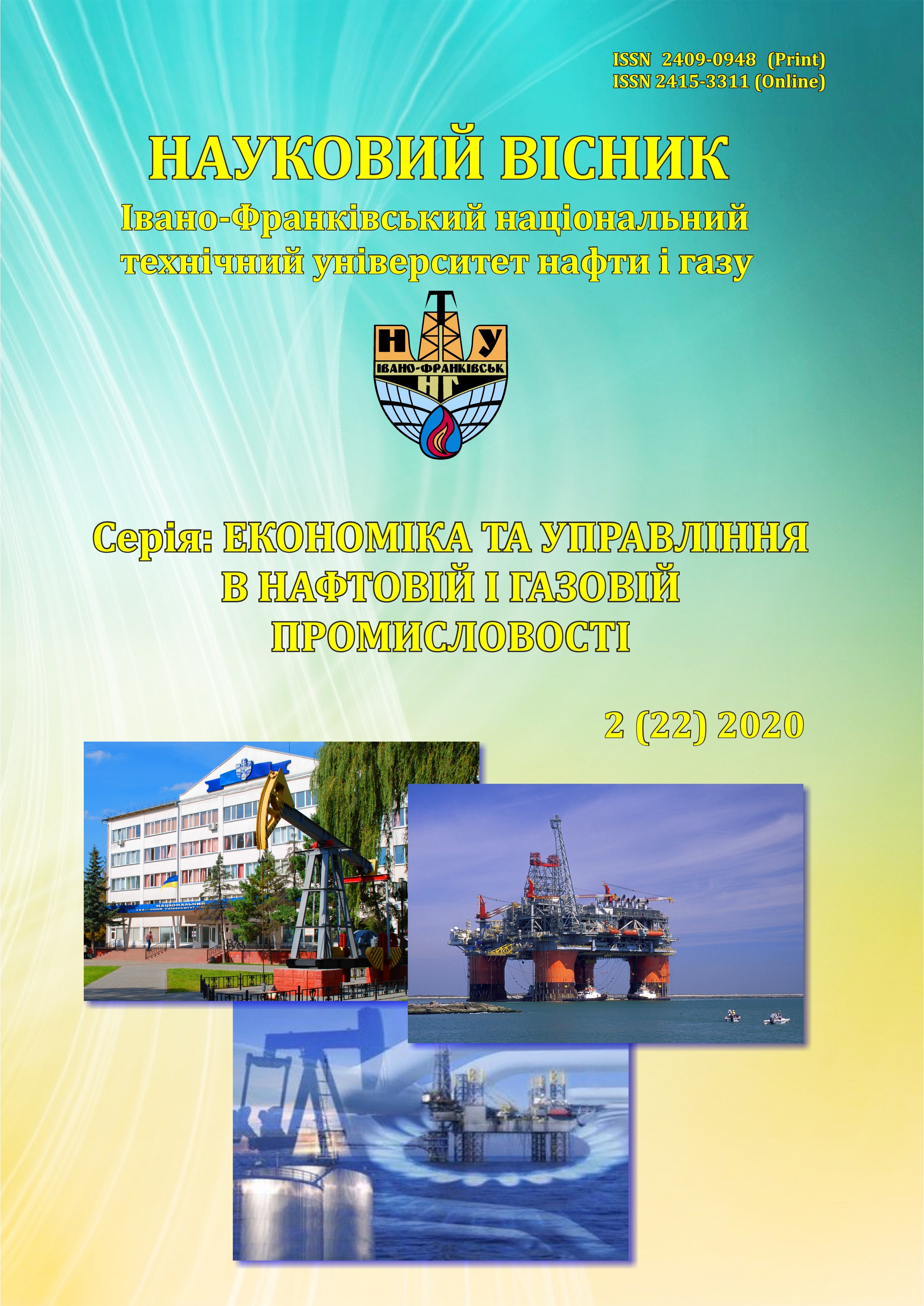МЕТОДИ РЕГУЛЮВАННЯ ТА ОПТИМІЗАЦІЇ ВИТРАТ ВИРОБНИЦТВА ПРОДУКЦІЇ АГРОСЕКТОРУ В СИСТЕМІ УПРАВЛІНСЬКОГО ОБЛІКУ МАЛОГО І СЕРЕДНЬОГО БІЗНЕСУ
DOI:
https://doi.org/10.31471/2409-0948-2020-2(22)-51-59Ключові слова:
витрати, управлінський облік, облік витрат, виробництво продукції, тваринництво, калькулювання.Анотація
У статті розглядається така сфера сільського господарства як тваринництво, яка залишається однією з основних галузей сільського господарства малого та середнього бізнесу, стосовно виробництва конкурентоспроможної продукції. Незважаючи на велику кількість наукових досліджень, питання регулювання та оптимізації витрат на виробництво тваринництва в системі управлінського обліку залишаються незрозумілими. Тому виникає необхідність у подальшому поглибленому вивченні теоретико-методологічних розробок, спрямованих на визначення методів регулювання та оптимізації витрат на виробництво тваринництва в системі обліку управління, що визначає актуальність обраної теми. У статті розглядаються питання регулювання та оптимізації витрат на виробництво тваринництва в системі обліку управління, розширення поняття «витрати», розглядаються методи обліку витрат на тваринництво та наголошуються основні моменти обліку витрат у виробництві.
Виробництво конкурентоспроможної продукції та забезпечення стабільної позиції підприємств на сільськогосподарському ринку вимагає зміни собівартості продукції тваринництва шляхом створення досконалої системи обліку управління, яка дозволяє надавати внутрішнім користувачам інформацію для ефективного управління.
Зазначається, що в теорії та практиці існує ряд особливостей класифікації витрат, які враховують різні аспекти сільськогосподарського підприємства та формують різноманітну інформацію для ефективних управлінських рішень. Таким чином, досвід та дослідження показують, що організація управлінського обліку в межах конкретного сільськогосподарського підприємства, орієнтована на задоволення конкретних інформаційних потреб системи управління, забезпечить його успіх у динамічних
економічних умовах та допоможе вирішити широке коло проблем для оптимізації виробництва тваринництва витрати.
Таким чином, формуються подальші дослідження щодо формування системи обліку собівартості продукції тваринництва, здатної генерувати інформаційні потоки для управлінських рішень, що вимагає обґрунтованого підходу до визначення об’єктів обліку та калькулювання витрат, встановлення їх взаємозв’язку та взаємозалежність.
Посилання
Butynets F. (2012). Vytraty vyrobnytstva ta yikh klasyfikatsiya dlya potreb upravlinnya.. Problems of theory and methodology of accounting, control and analysis. № 1. 11–18 [in Ukrainian].
Belova I. (2015). Sutʹ upravlinsʹkoho obliku ta yoho mistse v systemi upravlinnya pidpryyemstvom. Innovative economy. № 2 (57). 240–245. [in Ukrainian].
Golov S. (2007). Chy pereshkodzhaye P(s)BO 16 «Vytraty» ekonomichniy roboti na pidpryyemstvi? Accounting and auditing. № 5. 3–10. [in Ukrainian].
Hutsaliuk O. (2020). Obgruntuvannya orhanizatsiyno-ekonomichnoho mekhanizmu rehulyuvannya vytrat vyrobnytstva produktsiyi pidpryyemstv ahropromyslovoho kompleksu Ukrayiny. Substantiation of the organizational and economic mechanism of regulation of production costs of the enterprises of the agro-industrial complex of Ukraine. Peculiarities of socio-economic progress of the national economy in terms of information and technological challenges : a collective monograph / for science. ed. L. Kvasniy, I. Tatomir. Truskavets : Posvit. 102–111. [in Ukrainian].
Davydovych I. (2008). Upravlinnia vytratamy. Kyiv : Tsentr uchbovoi literatury. [in Ukrainian].
Len V. (2003). Upravlinsʹkyy oblik. Kiev : Knowledge-Press. [in Ukrainian].
Lukava I. (2003). Osoblyvosti diyuchoyi systemy upravlinsʹkoho obliku v roslynnytstvi. Reform of accounting, reporting and auditing in the system of agro-industrial complex of Ukraine: Status and prospects. Ch. I. Problems of adaptation of accounting of agro-industrial complex of Ukraine to international rules and requirements / ed. P. Sabluka, M. Demyanenko, V. Beetle. Kyiv : Institute of Agrarian Economics. 49–58. [in Ukrainian].
Paliy V. (2009). Upravlencheskyy uchet yzderzhek y dokhodov. Moscow : Infra-M. [in Russian].
Tarasova, T. O., Cherchata, A. O., Staverska, T. O. (2019). Oblikovo-analitychne zabezpechennia ryzyk-menedzhmentu v umovakh staloho rozvytku pidpryiemstva. Naukovyi visnyk Ivano-Frankivskoho natsionalnoho tekhnichnoho universytetu nafty i hazu (seriia «Ekonomika ta upravlinnia v naftovii i hazovii promyslovosti»), 2(20), 142-153. https://doi.org/10.31471/2409-0948-2019-2 (20)-142-153. [in Ukrainian]
Tkachenko N. (1997). Bukhhaltersʹkyy oblik na pidpryyemstvakh z riznymy formamy vlasnosti. Kyiv : A.S.K. [in Ukrainian].
Farion V. (2013). Sutnistʹ vytrat yak ekonomichnoyi katehoriyi. Bulletin of the Chernivtsi Trade and Economic Institute. Vip. 1 (49). Economic sciences. 44–47. [in Ukrainian].
Pro bukhhaltersʹkyy oblik ta finansovu zvitnistʹ v Ukrayini: zakon Ukrayiny vid 16 lypnya 1999 r., № 996-XIV (zi zminamy i dopovnennyamy). 1999, № 996-XIV. URL: www. ligazakon. ua. [in Ukrainian].
Polozhennya (standart) bukhhaltersʹkoho obliku 16 «Vytraty». URL: http://buhgalter911.com. [in Ukrainian].
Instruktsiya Pro zastosuvannya «Planu rakhunkiv bukhhaltersʹkoho obliku aktyviv, kapitalu, zobov'yazanʹ i hospodarsʹkykh operatsiy pidpryyemstv i orhanizatsiy» URL: https://zakon.rada.gov.ua/laws/show/z0893-99#Text [in Ukrainian].
Hutsaliuk O., Yaroshevska O., Shmatko N., Kulko-Labyntseva I., Navolokina A. (2020). Stakeholder approach to selecting enterprise-bank interaction strategies. Problems and Perspectives in Management. [in English].
##submission.downloads##
Опубліковано
Як цитувати
Номер
Розділ
Ліцензія
Положення про авторські права
Автори, які публікуються у цьому журналі, погоджуються з наступними умовами:
- Автори залишають за собою право на авторство роботи та передають журналу право першої публікації на умовах ліцензії Creative CommonsCC BY-NC-SA (https://creativecommons.org/licenses/by/3.0/), яка дозволяє іншим редагувати, вносити зміни і брати за основу для своїх творів цей твір некомерційним чином, поки автори похідних творів вказують авторів як авторів оригіналу і ліцензують свої твори на тих самих умовах;
- Автори мають право самостійно укладати додаткові угоди щодо не ексклюзивного розповсюдження наукової роботи у тому вигляді, в якому вона була опублікована цим журналом (наприклад, розміщувати роботу в електронному сховищі), за умови збереження посилання на першу публікацію роботи у цьому журналі;
- Політика журналу передбачає можливість розміщення авторами рукопису в мережі Інтернет (наприклад, у електронних сховищах інформації або на веб-сайтах), оскільки це сприяє виникненню продуктивної наукової дискусії та позитивно позначається на динаміці цитування опублікованої роботи.


.png)


.png)





